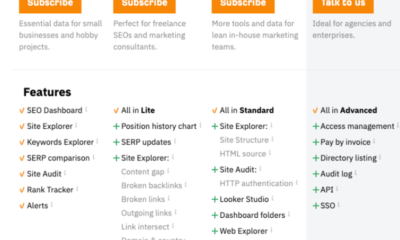Politics
Going Out on Your Own? 4 Ways Finances Differ for the Self-Employed
Published
1 year agoon
By
Drew Simpson
There’s nothing like the fantasy of saying goodbye to your office job and hello to being your own boss. But if you’ve got entrepreneurship on your mind, it’s important to understand the whole picture of what it means to be self-employed, especially with regard to finances.
Beyond the nearly limitless income potential comes complexities that, if not understood, can cause big problems.
Not that finances should scare you away from your dream of being self-employed. Individuals planning to strike out on their own can learn to manage the financial risks and differences that come along with self-employment.
So before you put in your two weeks’ notice, spend some time reading up in small business publications about finances for the self-employed.
1. Your cash flow will vary.
There’s a comforting predictability that comes with a salary. But in exchange for predictability, employees often accept limitations on their earning potential. For those who are self-employed, available finances can increase significantly — and decrease in an instant.
Depending on your industry, you may be able to charge a handsome rate for your services. But regardless of your hourly or project-based pricing structure, one thing is true for entrepreneurs across industries: income variability.
Even if you’ve locked down contracts and have an agreed-upon retainer, you’re not always in control. Some clients may have invoicing requirements ranging from 30 to 90 days. Also, depending on the documentation you need to provide for work completed, payment turnaround can slow.
As you consider entrepreneurship, identify the base-level requirements for your income and your business’s operations. Even if you have low overhead, you need to secure a minimum threshold that allows you to maintain stability.
Many entrepreneurs build a substantial nest egg prior to going solo. This cash reserve can help business owners confidently pursue their dreams. And while a savings balance will only last so long, it can help fill the gap between invoicing and payments.
Establish a process that outlines the payment terms you expect from your clients. Use this data to influence your rate structure and whether you charge per hour or per project.
Some business owners find project rates to be more profitable, but it puts pressure on being efficient with their time. Conversely, hourly rates can skyrocket, especially considering you’ll be on the hook to cover health insurance, retirement, and taxes. Don’t be shy in researching all the intricacies associated with taking on the entire scope of responsibility.
2. Securing loans requires predictability.
When you start to work for yourself, you gain a new type of freedom. However, much more responsibility is on you to keep pace and deliver for your clients.
Frequently, entrepreneurs also reap the rewards of greater income by working for themselves rather than for a corporation. But this increased financial bandwidth doesn’t allow you to side-step established lending practices.
Most employees in the U.S. are employed at will, meaning they could be fired at any time. Yet would-be creditors tend not to see things that way.
Even if your self-employed income and available finances are substantially higher than in years prior, in lenders’ eyes, it’s a whole new ballgame. You’ll likely need to provide more proof that you’re a credit-worthy customer. Like it or not, self-employment often indicates a level of risk for the lender.
Research mortgages for self-employed individuals to get an understanding of the differences compared to traditional lending. To bolster your loan application, you’ll need to provide a year-over-year history of income, usually two years or longer.
Also helpful is proof of long-term contracts that can provide stability of income. For example, if you’ve signed a five-year retainer for consulting services, this can give loan providers assurance that your income is solid.
3. Taxes present complexities and opportunities.
Taxes are often one of the most dreaded realities of entrepreneurship. Along with the complexities of managing variable income, entrepreneurs are on the hook for some hefty taxes.
On the up side, the self-employed enjoy a robust list of deductions and write-offs associated with conducting business.
Check with the Internal Revenue Service’s website for specifics on the current year’s tax laws. These will shift year over year, so it’s a smart move to save this website to your favorites list. Additionally, engaging an accountant with self-employment expertise can help you avoid tax mishaps and maximize your opportunities.
If you have a home office, you can account for business use on your taxes, reducing your overall tax obligation. There are standardized or specific ways you can do this, so simulate both to determine which provides the best benefit. Get familiar with the deductions available and reduce your overall taxable income.
Every dollar you save on taxes can be devoted to growing your business, saving for the future, or simply enjoying.
If you’re ever unsure about your tax obligation, don’t just guess. Discrepancies on your self-employed taxes may flag your return for an audit. And if you’re audited, you will be required to provide documentation for your claims. Even if you were able to confirm the accuracy of your return, the time lost due to an audit has consequences.
Keep scrupulous tax records so that in the event of an audit, you’ll already have everything you need.
4. Retirement savings is 100% on you.
Gone are the days of an employer match to your 401(k), but that doesn’t mean you can’t secure a solid retirement. Self-employed individuals will simply need to take a strategic approach to retirement savings.
Just like a W-2 employee, you’ll need to determine how much you can afford to set aside for the future. Research your retirement plan options across Roth IRAs, SEP-IRAs, Solo 401(k)s, and others available for the self-employed.
Pay special attention to account fees, expense ratios, and minimums to select the option that works best for you.
Leverage the tax-saving potential of pre-tax contributions while taking advantage of the long-term benefits of post-tax accounts like Roth IRAs. Especially if your income level is likely to rise in the future, a Roth IRA can yield major tax savings.
Consider your current and future potential tax brackets to make wise choices now. The better you plan your retirement strategy today, the more flexibility you’ll have as you advance toward retirement.
Celebrate the power of being your own boss.
Waking up each day with a renewed sense of purpose is one of the hallmarks of happy entrepreneurship.
While it comes with significant responsibility and a steep learning curve, it can be one of the most rewarding life choices you can make. Whether your dream is to achieve more autonomy, make an impact, or harness your creativity, self-employment creates opportunities.
Celebrate the power of your self-employment by bringing fresh perspectives and high-quality service to your clients. They’ll appreciate the expertise you provide, and you’ll enjoy a vocation that uses your talents for the highest good. Meanwhile, you can benefit from the financial opportunities that come along with self-employment now and in the future.
Image Credit: Anete Lusina; Pexels; Thanks!
Deanna Ritchie
Managing Editor at ReadWrite
Deanna is the Managing Editor at ReadWrite. Previously she worked as the Editor in Chief for Startup Grind and has over 20+ years of experience in content management and content development.
You may like
-


Four ways AI is making the power grid faster and more resilient
-


Plastic is a climate change problem. There are ways to fix it.
-


15 Proven Ways to Increase Customer Engagement and Build Loyalty
-


Four Clever Ways to Use Tiered Pricing for Maximum Profit
-


5 Ways to Reduce Customer Churn
-


5 Ways to Use JavaScript to Add Interactivity to Your Website
Politics
Fintech Kennek raises $12.5M seed round to digitize lending
Published
7 months agoon
10/11/2023By
Drew Simpson
London-based fintech startup Kennek has raised $12.5 million in seed funding to expand its lending operating system.
According to an Oct. 10 tech.eu report, the round was led by HV Capital and included participation from Dutch Founders Fund, AlbionVC, FFVC, Plug & Play Ventures, and Syndicate One. Kennek offers software-as-a-service tools to help non-bank lenders streamline their operations using open banking, open finance, and payments.
The platform aims to automate time-consuming manual tasks and consolidate fragmented data to simplify lending. Xavier De Pauw, founder of Kennek said:
“Until kennek, lenders had to devote countless hours to menial operational tasks and deal with jumbled and hard-coded data – which makes every other part of lending a headache. As former lenders ourselves, we lived and breathed these frustrations, and built kennek to make them a thing of the past.”
The company said the latest funding round was oversubscribed and closed quickly despite the challenging fundraising environment. The new capital will be used to expand Kennek’s engineering team and strengthen its market position in the UK while exploring expansion into other European markets. Barbod Namini, Partner at lead investor HV Capital, commented on the investment:
“Kennek has developed an ambitious and genuinely unique proposition which we think can be the foundation of the entire alternative lending space. […] It is a complicated market and a solution that brings together all information and stakeholders onto a single platform is highly compelling for both lenders & the ecosystem as a whole.”
The fintech lending space has grown rapidly in recent years, but many lenders still rely on legacy systems and manual processes that limit efficiency and scalability. Kennek aims to leverage open banking and data integration to provide lenders with a more streamlined, automated lending experience.
The seed funding will allow the London-based startup to continue developing its platform and expanding its team to meet demand from non-bank lenders looking to digitize operations. Kennek’s focus on the UK and Europe also comes amid rising adoption of open banking and open finance in the regions.
Featured Image Credit: Photo from Kennek.io; Thank you!
Radek Zielinski
Radek Zielinski is an experienced technology and financial journalist with a passion for cybersecurity and futurology.
Politics
Fortune 500’s race for generative AI breakthroughs
Published
7 months agoon
10/11/2023By
Drew Simpson
As excitement around generative AI grows, Fortune 500 companies, including Goldman Sachs, are carefully examining the possible applications of this technology. A recent survey of U.S. executives indicated that 60% believe generative AI will substantially impact their businesses in the long term. However, they anticipate a one to two-year timeframe before implementing their initial solutions. This optimism stems from the potential of generative AI to revolutionize various aspects of businesses, from enhancing customer experiences to optimizing internal processes. In the short term, companies will likely focus on pilot projects and experimentation, gradually integrating generative AI into their operations as they witness its positive influence on efficiency and profitability.
Goldman Sachs’ Cautious Approach to Implementing Generative AI
In a recent interview, Goldman Sachs CIO Marco Argenti revealed that the firm has not yet implemented any generative AI use cases. Instead, the company focuses on experimentation and setting high standards before adopting the technology. Argenti recognized the desire for outcomes in areas like developer and operational efficiency but emphasized ensuring precision before putting experimental AI use cases into production.
According to Argenti, striking the right balance between driving innovation and maintaining accuracy is crucial for successfully integrating generative AI within the firm. Goldman Sachs intends to continue exploring this emerging technology’s potential benefits and applications while diligently assessing risks to ensure it meets the company’s stringent quality standards.
One possible application for Goldman Sachs is in software development, where the company has observed a 20-40% productivity increase during its trials. The goal is for 1,000 developers to utilize generative AI tools by year’s end. However, Argenti emphasized that a well-defined expectation of return on investment is necessary before fully integrating generative AI into production.
To achieve this, the company plans to implement a systematic and strategic approach to adopting generative AI, ensuring that it complements and enhances the skills of its developers. Additionally, Goldman Sachs intends to evaluate the long-term impact of generative AI on their software development processes and the overall quality of the applications being developed.
Goldman Sachs’ approach to AI implementation goes beyond merely executing models. The firm has created a platform encompassing technical, legal, and compliance assessments to filter out improper content and keep track of all interactions. This comprehensive system ensures seamless integration of artificial intelligence in operations while adhering to regulatory standards and maintaining client confidentiality. Moreover, the platform continuously improves and adapts its algorithms, allowing Goldman Sachs to stay at the forefront of technology and offer its clients the most efficient and secure services.
Featured Image Credit: Photo by Google DeepMind; Pexels; Thank you!
Deanna Ritchie
Managing Editor at ReadWrite
Deanna is the Managing Editor at ReadWrite. Previously she worked as the Editor in Chief for Startup Grind and has over 20+ years of experience in content management and content development.
Politics
UK seizes web3 opportunity simplifying crypto regulations
Published
7 months agoon
10/10/2023By
Drew Simpson
As Web3 companies increasingly consider leaving the United States due to regulatory ambiguity, the United Kingdom must simplify its cryptocurrency regulations to attract these businesses. The conservative think tank Policy Exchange recently released a report detailing ten suggestions for improving Web3 regulation in the country. Among the recommendations are reducing liability for token holders in decentralized autonomous organizations (DAOs) and encouraging the Financial Conduct Authority (FCA) to adopt alternative Know Your Customer (KYC) methodologies, such as digital identities and blockchain analytics tools. These suggestions aim to position the UK as a hub for Web3 innovation and attract blockchain-based businesses looking for a more conducive regulatory environment.
Streamlining Cryptocurrency Regulations for Innovation
To make it easier for emerging Web3 companies to navigate existing legal frameworks and contribute to the UK’s digital economy growth, the government must streamline cryptocurrency regulations and adopt forward-looking approaches. By making the regulatory landscape clear and straightforward, the UK can create an environment that fosters innovation, growth, and competitiveness in the global fintech industry.
The Policy Exchange report also recommends not weakening self-hosted wallets or treating proof-of-stake (PoS) services as financial services. This approach aims to protect the fundamental principles of decentralization and user autonomy while strongly emphasizing security and regulatory compliance. By doing so, the UK can nurture an environment that encourages innovation and the continued growth of blockchain technology.
Despite recent strict measures by UK authorities, such as His Majesty’s Treasury and the FCA, toward the digital assets sector, the proposed changes in the Policy Exchange report strive to make the UK a more attractive location for Web3 enterprises. By adopting these suggestions, the UK can demonstrate its commitment to fostering innovation in the rapidly evolving blockchain and cryptocurrency industries while ensuring a robust and transparent regulatory environment.
The ongoing uncertainty surrounding cryptocurrency regulations in various countries has prompted Web3 companies to explore alternative jurisdictions with more precise legal frameworks. As the United States grapples with regulatory ambiguity, the United Kingdom can position itself as a hub for Web3 innovation by simplifying and streamlining its cryptocurrency regulations.
Featured Image Credit: Photo by Jonathan Borba; Pexels; Thank you!
Deanna Ritchie
Managing Editor at ReadWrite
Deanna is the Managing Editor at ReadWrite. Previously she worked as the Editor in Chief for Startup Grind and has over 20+ years of experience in content management and content development.
